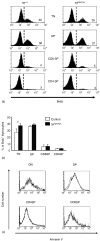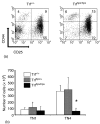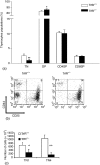Transferrin is required for early T-cell differentiation
- PMID: 15270724
- PMCID: PMC1782535
- DOI: 10.1111/j.1365-2567.2004.01915.x
Transferrin is required for early T-cell differentiation
Abstract
Transferrin, the major plasma iron carrier, mediates iron entry into cells through interaction with its receptor. Several in vitro studies have demonstrated that transferrin plays an essential role in lymphocyte division, a role attributed to its iron transport function. In the present study we used hypotransferrinaemic (Trf(hpx/hpx)) mice to investigate the possible involvement of transferrin in T lymphocyte differentiation in vivo. The absolute number of thymocytes was substantially reduced in Trf(hpx/hpx) mice, a result that could not be attributed to increased apoptosis. Moreover, the proportions of the four major thymic subpopulations were maintained and the percentage of dividing cells was not reduced. A leaky block in the differentiation of CD4(-) CD8(-) CD3(-) CD44(-) CD25(+) (TN3) into CD4(-) CD8(-) CD3(-) CD44(-) CD25(-) (TN4) cells was observed. In addition, a similar impairment of early thymocyte differentiation was observed in mice with reduced levels of transferrin receptor. The present study demonstrates, for the first time, that transferrin itself or a pathway triggered by the interaction of transferrin with its receptor is essential for normal early T-cell differentiation in vivo.
Figures




References
-
- Kaplan J. Mechanisms of cellular iron acquisition: another iron in the fire. Cell. 2002;111:603–6. - PubMed
-
- Levy JE, Jin O, Fujiwara Y, Kuo F, Andrews NC. Transferrin receptor is necessary for development of erythrocytes and the nervous system. Nat Genet. 1999;21:396–9. - PubMed
-
- Tormey DC, Imrie RC, Mueller GC. Identification of transferrin as a lymphocyte growth promoter in human serum. Exp Cell Res. 1972;74:163–9. - PubMed
-
- Brekelmans P, van Soest P, Voerman J, Platenburg PP, Leenen PJ, van Ewijk W. Transferrin receptor expression as a marker of immature cycling thymocytes in the mouse. Cell Immunol. 1994;159:331–9. - PubMed
Publication types
MeSH terms
Substances
Grants and funding
LinkOut - more resources
Full Text Sources
Molecular Biology Databases
Research Materials
Miscellaneous
